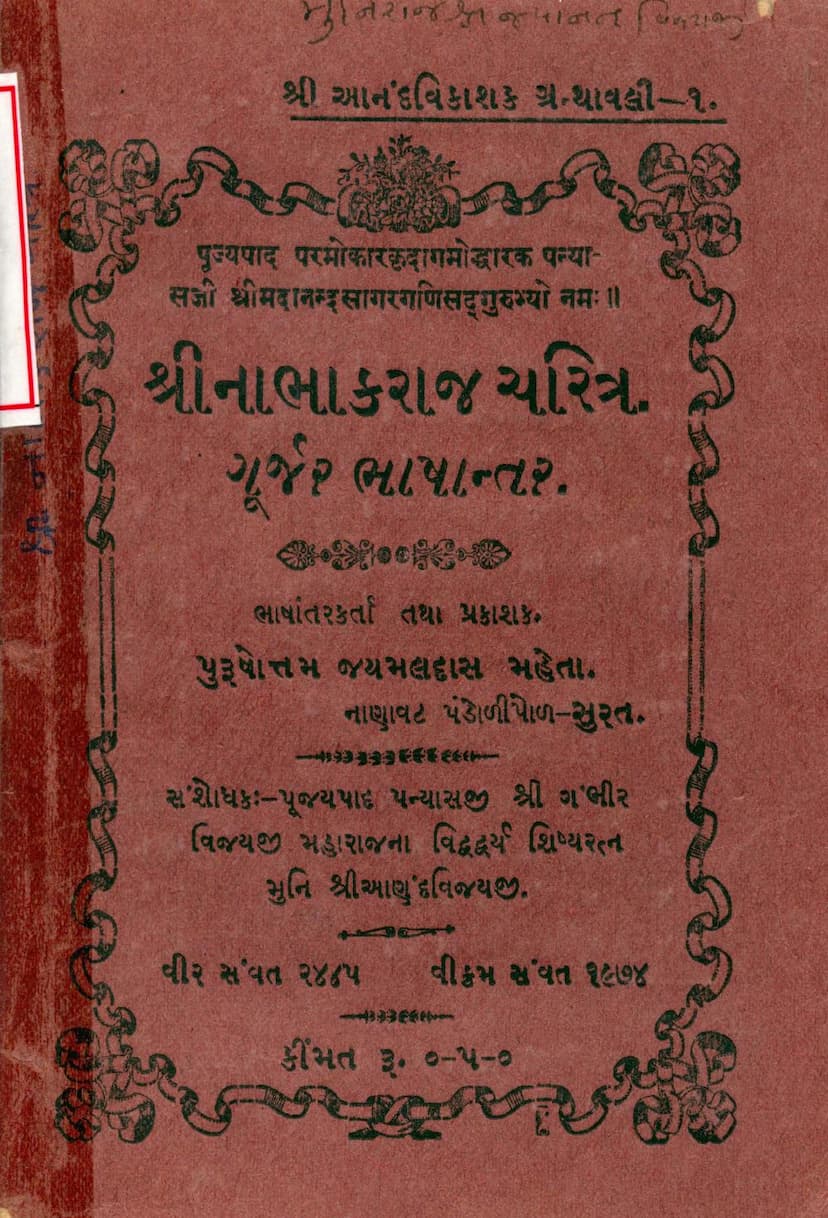Nabhak Raj Charitra
Added to library: September 2, 2025

Summary
Here's a comprehensive summary of the Jain text "Nabhak Raj Charitra":
Book Title: Nabhak Raj Charitra (The Life Story of King Nabhak) Author(s): Purushottam Jaymaldas Mehta (Translator and Publisher), Anandvijay (Researcher) Publisher: Purushottam Jaymaldas Mehta Original Author: Merutungaacharya (implied as the author of the original story)
This book is a Gujarati translation and elaboration of the story of King Nabhak, presented within the framework of Jain teachings and principles. The core narrative revolves around the consequences of mishandling and destroying Devadravya (wealth belonging to the divine, often associated with temples and religious institutions) and the importance of righteous conduct, adherence to dharma, and the value of devotion to the Tirthankaras, particularly Lord Rishabhdev.
Key Themes and Content:
-
The Importance of Devadravya: The primary moral of the story emphasizes the severe repercussions of misusing or destroying wealth dedicated to the divine. The text meticulously details how such actions lead to immense suffering, rebirth in hellish realms, and various unfortunate existences across multiple lifetimes. The story of Nabhak himself, and several allegorical tales like that of the merchant Nagasreshti and the donkey, illustrate this point vividly.
-
The Story of King Nabhak:
- Nabhak is depicted as a righteous and prosperous king.
- His life is intertwined with discussions about the significance of pilgrimage, specifically to the holy mountain Shatrunjaya.
- A significant part of his story involves his earnest desire to undertake the Shatrunjaya pilgrimage, but he faces numerous obstacles and delays, often due to unforeseen circumstances or the actions of others.
- Through these challenges, King Nabhak learns valuable lessons about karma, perseverance, and the complexities of spiritual practice.
-
Allegorical Tales and Illustrations:
- The Merchant Nagasreshti and his brother Simha: This tale highlights the downfall of Simha who, influenced by his wife and greed, conspires to misuse wealth meant for the divine. This leads to his repeated rebirths in hellish realms and as various animals, experiencing immense suffering due to his past actions. His brother, Nagasreshti, who correctly uses the wealth for the Shatrunjaya pilgrimage, attains a better destiny.
- The Story of King Bhartrihari: This is used to illustrate how attachment to women can lead to flawed judgment and negative consequences, even for wise individuals.
- The Story of the Brahmin who studied women's conduct: This story serves as a caution against the deceptive nature of women and the potential for men to be misled, emphasizing the need for discernment.
- The Story of King Chandraditya: This narrative illustrates the karmic consequences of past deeds, showing how the king, despite performing good deeds in his current life, suffers from a skin disease due to a past transgression of using Devadravya (sandalwood) for personal adornment. His journey of penance and seeking spiritual guidance is detailed.
- The Story of the Donkey: This allegory further reinforces the idea that even lower beings can manifest certain karmic predispositions and that actions have direct consequences.
-
Jain Philosophy and Ethics: The book weaves in various Jain ethical principles:
- Karma Siddhantha: The pervasive concept of karma and its inexorable law of cause and effect is central. Every action, thought, and word has a consequence that spans lifetimes.
- Ahimsa (Non-violence): The text strongly advocates for Ahimsa in thought, word, and deed, emphasizing the negative consequences of harming living beings, especially in the context of religious rituals or personal gain.
- The Importance of Righteous Conduct: The book stresses the need for Samayika (equanimity), Pramanita (moderation), and following the teachings of the Jinas (Tirthankaras).
- The Four Bhavanas (Meditations): The text touches upon the importance of Maitri (friendship), Pramoda (joy in others' virtue), Karunya (compassion), and Madhyastha (neutrality).
- The Path to Moksha (Liberation): The ultimate goal of liberation is presented as achievable through right faith, knowledge, and conduct, emphasizing detachment from worldly pleasures and strict adherence to Jain practices.
-
Emphasis on Righteous Livelihood: The book strongly advocates for earning wealth through Nyaya (justice and righteousness). It details how wealth earned through unfair means not only fails to bring true happiness but also leads to negative karmic repercussions. The importance of honesty in financial dealings and refraining from exploitative practices is highlighted.
-
The Role of Gurus: The narrative underscores the significance of guidance from enlightened gurus (spiritual teachers) in understanding dharma and navigating the complexities of karma and spiritual practice. King Nabhak receives crucial advice and explanations from his gurus.
-
The Shatrunjaya Mahatmya: The book extensively describes the glory and merits of undertaking pilgrimage to the holy mountain Shatrunjaya, citing various scriptural references and poetic verses to emphasize its sanctity and the spiritual benefits it offers.
Structure and Presentation:
- The book begins with Mangalacharan (auspicious invocations).
- It includes a detailed "Guthbhaktavyata" (preface/introduction) explaining the structure of Jain scriptures and the categorization of knowledge, placing the Charitra (biographical) section into context.
- The narrative is presented in a story-telling format, interwoven with philosophical explanations and moral lessons.
- The Gujarati translation is enriched with explanations and elaborations by the translator and publisher, Purushottam Jaymaldas Mehta, who also emphasizes the relevance of these teachings in contemporary times, particularly concerning the proper handling of temple wealth.
- The book includes supportive poems and verses, as well as advice for devotees visiting Jain temples.
Overall Message:
"Nabhak Raj Charitra" serves as a powerful moral and spiritual guide, reminding readers of the profound impact of their actions, especially concerning Devadravya and adherence to Jain dharma. It emphasizes that true happiness and ultimate liberation are attained through righteous conduct, devotion, and detachment, and that the path of virtue, though sometimes challenging, ultimately leads to lasting well-being.